 Note:
July 22, Oakland, sunset.
Note:
July 22, Oakland, sunset.
This piece was originally written in May 2000, before my trip to China
that year. Now in the following July, I am able to finish editing
and gathering the images. All but one of the images are from Jean’s
own work, one is mine made the last few weeks to honor hers and/or to take
the place of one of hers that is now lost or unavailable. Each image
is marked accordingly.
As
I began to work this evening, an old song came to mind, suggested partly
by the time of day, and partly by the work that I am doing...
In the gloaming, oh my darling...
Softly come and softly go...
The
late low sun shines through the dining room window; the chandelier glows
with sunset light—that light, that moment always so beautiful for me, that
light and moment so filled with the essence of our home here together,
mine here now. (Stephanie has somehow never taken dwelling here, nor
have I in her place in Montreal. Last month when she was here for a
few days, I showed her that summer sunset light in the dining room
chandelier and said, “I think it is very beautiful.” I did not speak
of the emotional bonding it represents for me.)
In
the gloaming oh my darling softly come and softly go these thoughts about
your art that I wrote more than two months ago and of which I will tonight
complete the edit and illustrations.
*
I had met Jean in the basement of the Art
Department in the fall of 1948. She had just returned from summer at
an artist's colony on the shore of Lake Aijiji in Guadalajara. She
was exotic and of the south. I felt myself to be of the north, and
the attraction between us was mutual and total.
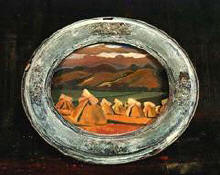 Jean
Martin: Untitled (Havest)
Jean
Martin: Untitled (Havest)
Oil on canvas board, approx 9 x 12 in.
Jean continued to paint in the first year after we were married. I
loved her paintings... of which only a few have survived plus one more as
a slide. The earliest of the survivors is a small landscape painted
before we met. Fields, shocks of grain, purple hills in the
distance. I framed it in an oval frame left over from someone's
1900's portrait, painting the brown frame white and then glazing it with a
bluish purple like the one Jean had used for the mountains at the back of
the fields in the painting. Jean told me that Auntie's boyfriend's
sister Flo had questioned her about it and had dismissed it as a "daub."
Then Jean stopped painting -- I guess until we met.
 Jean
Martin: Tree
Jean
Martin: Tree
Oil on canvas, 36 x 24 in.
The second painting of Jean’s that I have from before we were married was
made in the
Art
Department in the fall of 1949. It is of
the old fruit tree outside my room on
McAllister Street in San Francisco. It shines with the light of our
morning lovemaking in that room.
Thinking now, I remember a third
painting of hers from that time that I still have... enamel on panel (in
those days, we all used enamel from the hardware store), a couple of
large, strange forms in simple colors, and one small black form sticking
out like a scorpion's sting.
I don't think Jean painted anything
during our six months in the Studio Gallery, but after that when we were
painting in the loft of the old dairy (in Berkeley and near the campus!),
she began work on an immense canvas (four by six feet?), a slough she had
seen northwest of Vallejo with an old ferry boat docked there. While
she was working on it, she also made some still life paintings and some
little drawings and watercolors. I still have one of the still lifes.
Another one, the best one, she gave to J. DeFeo the week that J. lived
with us after her breakup with Wally Hedrick and before she moved to Ross.
It was in the mid 1960s. I gave J. a little portfolio of pencil
drawings of poppies, and the tall black “landscape" from 1948-49.
One Sunday morning a year
later, I decided we had to go to see the sunset at Pyramid Lake in Nevada,
and that we should go to Ross first to see J. Jean, Tony, Fredricka
(and Demian?) and I drove to J.'s. Jean's still life was under the
kitchen sink; the pencil drawings from my portfolio were scattered in a
heap of wastepaper in the living room; and the tall black landscape was
outside leaning against a tree, the sprinkler system for the garden
finishing in the summer what the winter rains had begun. Hours later
we got to Pyramid Lake in time for the sunset -- it was a silent and
beautiful slow dying rose on the peaks and cliffs to the east as the water
before us sank through turquoise to night -- and then we spent the night
driving home.
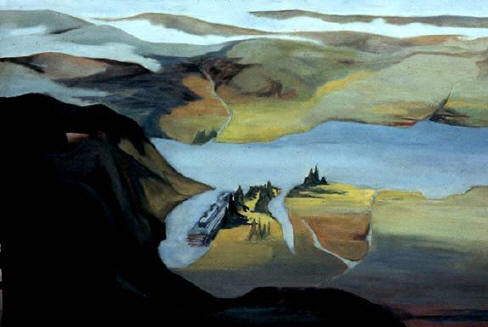
Jean Martin: Ferry Boat, 1950
Oil on canvas, approx 48 x 72 in.
But back to the big painting of the
ferry boat in the slough (I have read enough Jung to see the watery,
grassy slough as the unconscious and the ferry as the Self on its
journey), and the little watercolors Jean was also making that I never
saw. Sam Francis had found the old barn of dairy for a studio, and
we shared the loft with him. Jean had made a little watercolor of
mushrooms in the dawn. Sam sneered at it as—what were the words?...
paltry? women's stuff? trivial? worthless but typical?... Jean never
painted again.
Jean saw and loved the small things at
our feet. I looked only for the cosmic signs beyond the horizon.
I never knew what Sam looked for except "fame and the love of women” for
whom in the classic phrase of my high school years, "He’s 4F—Find 'em,
feel 'em, fuck 'em, forget 'em."
Those little things at our feet: bugs
and leaves, flowers, mushrooms, all manner of the small things—and animals
too, we always had a dog or two that wandered in and needed love—those
were her care. And somehow too often in all the years we were
together, each time her need for expression reached out to speak her love
for the fragile beings in the world, some boor (male or female) like Sam
trampled them to death.
Those little things at our feet: sometimes
I too looked down and saw. But I did not see the fragile shining
things that give sentiment and beauty to life. No, I only saw the
cracks in the sidewalk and the dirt in the gutter, the dark horror that
mirrored my own irrevocable sense of sexual guilt and despair. A few
years after our time in the loft over the dairy, during my brief yellow
ochre plus pthalo blue plus cadmium red figure painting period, I also
painted a still life of what I saw at my feet. I destroyed it soon
after painting it, but memorialized it as the frontispiece in my
"Dirt in the Gutter" booklet of 1987. I wish now I still had the
original painting, but most of all I wish I had the little watercolor of
mushrooms in the dawn, because that was what we were then, tender beings
growing up out of the darkness and seeking the sun.
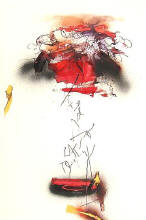 My
#16 July 2000,
My
#16 July 2000,
Untitled after Jean’s mushrooms (my third try)
Acrylic on paper, 30 x 44 in.
People in art education sometimes excuse their clumsy and vicious
diatribes at student's expense by saying, "If they can't stand up to it,
they should give up now." Sam Francis was never an educator, and I
don't think he would have excused himself that way even if he were.
He was always too busy building his own ego to notice that its
aggrandizement was due to his denigration of those around him.
Jean did not paint again. After
almost a year she moved instead into an area of visual expression no one
around her had used at that time and so could not hoist themselves by
belittling her. She began to make what we now call "constructions,"
that is, assemblages of found objects which can become symbols quite other
than the miscellaneous fragments from which they were constructed. I
remember that my father, seeing her interest in putting these things
together, gave her some tools to do it with. The object I remember
that she made was a boat—the sail a vertical scrap of woven wire net, a
random piece of wood for the hull, a dowel for the mast and a tangled
strand of hemp rope to hold it all together. I thought of it then
and remember it now as our ship for sailing among the stars.
The ship and all the other projects
like it were soon lost in the chaos of the pregnancy and birth and infancy
of Demian. I finished my work for the teaching credential in June
1951; Sam moved to
Paris to make his fortune in the great world a month or two before; and we
moved to Maxwell for my first teaching job in late September.
The Maxwellains thought we were an odd
couple, and to prove it one of our friends in
Berkeley sent Jean a letter addressed to the "Contessa
Fisette di Martin." When the Post Office Lady finished telling her
friends, the whole town knew Jean was an Italian war-bride. The
local Lady's Aid Society had already invited her to one of their Women's
Afternoon Teas. After the letter, they never invited her again.
(Meanwhile, the men of the town had already decided that I would not do
for their weekly club meeting in the room over the corner bank. One
of them once apologized to me because, "you know, it just wouldn't work
out.") And so, we were ostracized. I painted every night in the
garage of our house (how cold in the winter!); while Jean played a lute
and sang folk songs in the living room. The need for self-expression
never stops.
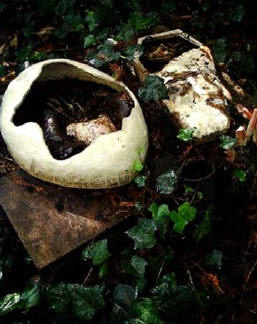 Jean
Martin: The “Family Altar under the Redwoods,” with The Egg
of Night on the left (that’s a winged heart on the inside), and Mom’s
Apple Pie (the coffin) on the right.
Jean
Martin: The “Family Altar under the Redwoods,” with The Egg
of Night on the left (that’s a winged heart on the inside), and Mom’s
Apple Pie (the coffin) on the right.
Ceramic.
When we returned to Berkeley in 1954 and then moved to Harrison Street in
1955, Jean began to work in ceramic sculpture, taking a night class with
Stephen de Staebler at SFAI. I still have the apple box of
Hesperian Fruit, The Grand High Inquisitor (Jean’s grandmother,
mother and aunt all rolled into one hooded monk), her Mom’s Apple Pie
in the shape of a coffin, her coffin with lid as a masked Head of
Medusa, her Tortoise that Turns the World, her Egg of Night
[a winged heart] Fertilized by the Wind, a Dragon-Salamander to
go in front of the fireplace (it got too hot and cracked in two), and
assorted fragments in the manner of bits Roman sculpture patched into
Renaissance walls.
Fredricka was born in 1956. Soon
it was not possible to have the time to take night courses at SFAI, and
soon the creative drive that made all those ceramic pieces was drowned
once more in the chaos of the daily life of children, jobs and family.
A few years passed and we moved to Monte Vista in October of 1959.
Tony was born in May of 1960, and the possibility of creative work in art
further submerged.
By then, Jean was Curator at the
California Historical Society, and all her creative energies went to
building the collection, preparing the first significant show and catalog
of the collection, and then organizing the first (and only) big
fund-raiser event the Society ever had—“A Night on the Barbary Coast,” a
huge block party on Pacific Avenue and Gold and Sansome Streets with movie
star guests and the just beginning topless joints as draws.
The party was a big success; it even
made money for the Society. Shortly after, Jean was offered the job
as Registrar at the Oakland Museum of History, under Henrietta Perry as
Director. By all accounts, Henrietta was a complete nut, the kind
who stays in civil service jobs forever because no one knows how to get
rid of them. Soon enough, all Paul Mills’ efforts at the
Oakland Art Gallery to build a new museum for himself bore fruit.
However, the new museum would include not only art, but also history and
science—and Paul would not be Director. A consultant, Alan McNab,
the Director of the Art Institute of Chicago, was selected to advise the
museum board on how to proceed and what to build. He chose Jean as
his adviser for design and development of the history section, and then
offered her the job of Registrar at The Art Institute of Chicago. In
order to get her, he offered me the job of Head of the Design Department
of the School of the Art Institute of Chicago.
We both declined—by
that time I was Administrator of the Art Bank (the position is now
Director of Exhibitions and Public Programs) and Executive Secretary of
the San Francisco Art Association; and Jean had been promised the job of
the Curator of the History Division once they got rid of Henrietta Perry.
They did get rid of Henrietta, but gave the job to Tom (I no longer
remember his last name). Jean was a woman with a BA in Art; Tom was
a man with an MA in Anthropology. Jean left the museum world, saying
never again would she have a job where if you decided to leave there were
no other nearby jobs you could go to. She went back to school at
Merritt College, got an AA in Computer Science, and then a job teaching
computer science at a local trade school run by Control Data, then big in
the world of information, now I think long gone. She stayed at
Control Data, teaching 5 hours per day five days per week with a two-week
vacation until the mid 1970s when, once again, she was passed over for the
Directorship in favor of a man with less experience. She resigned
and went to work for Del Monte Corporation as a programmer, then systems
analyst, then Manager of Information Services.
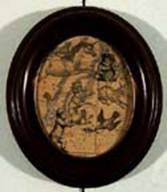 Jean
Martin: Babies in the Sky
Jean
Martin: Babies in the Sky
Collage, approx. 10 x 6 in.
About Jean's art during these years. Those 1950’s years at the
Oakland Museum were the years of ceramics. During the years at the
Historical Society, the development of the Society’s collection and the
public world became her creative focus... although she began to make
collages from pieces cut from 17-18th Century engravings of
famous paintings. I still have many of these, made during the
Control Data and early Del Monte years. Jean entered these in juried
exhibitions, being accepted once but usually not—after all, it was the
days of late Pop and early Conceptual. During the later years at Del
Monte—late 1970’s and early 1980’s—Jean began to make tapestries and also
what were regarded as quilts. She entered these in quilt, fabric and
textile exhibitions—surely there would be no men in quilt exhibitions to
shove women and sewing aside as being "paltry, trivial women's stuff."
We were, however, in the period of "creative" textiles, when women
rejected women who did not weave tree branches into their tapestries and
quilt boulders into their coverlets. Jean was rejected as "old hat."
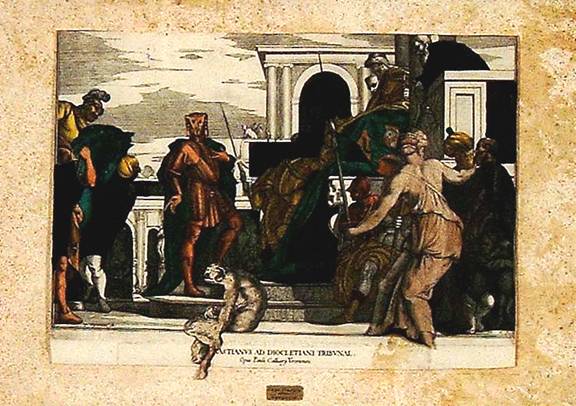
I matted this collage of Jean’s in a faux marble paper that I made after
she died. I also made the little gold plaque that says, “Jean
Martin after Veronese.”
The collage is 12 x 16 inches.
When Jean's cancer was
diagnosed in summer of 1982, she began to sew large, meditative/symbolic
wall hangings. There was much hope at that time for imagery as a
part of cancer therapy. In the event and in her (our) own case, the
cancer overcame the meditative sewing... perhaps because the world of
imagery and the unconscious is far more complex and devious than we in our
day world know, and also perhaps because when you wish (and there had been
times before the onset of her illness when she had wished she were dead)
sometimes you get it.
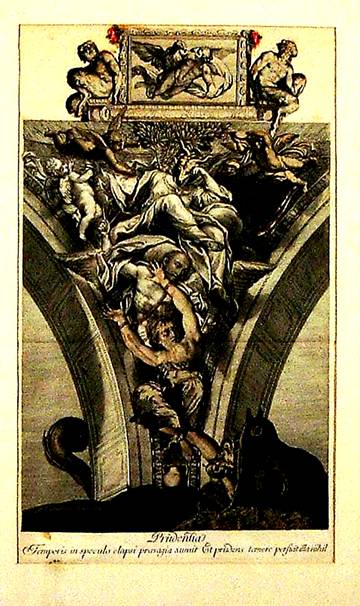
“Prudentia,” collage, 22 x 12 inches.
Made from an engraving of the frescos in the
Farnese Palace in Rome?
If I were to sum up what I experienced
then and I now think and know of Jean's creative life, I think she had
great drive and talent—and in those "creativity studies" terms, she had
fluidity, flexibility, originality and elaboration. What she did not
have was opportunity. Like most women of her generation, care and
love of children and the obligations of jobs and household simply thrust
aside the yet unquenchable need for self-expression. The work would
rise to a great height and then be snuffed out again and again first by
family and second by the art world's own personalities and events and
fashions.
And in that snuffing out I too played
an unwitting role. Although I regarded her art to be as important to
her as mine was to me, I was yet the artist in our family and she was the
amateur. Secondly, and an example of this attitude even in myself,
shortly after we moved into Monte Vista, I decided to move out of what we
had always agreed would be my studio over the garage and to move into the
large basement area. Thus, Jean would have my large space over the
garage to work on her ceramics and sculpture—in fact would have “a room of
her own.” There will never leave the imagery in my mind the sight of
Fredricka scrubbing the studio sink (I had left it filthy with old paint)
so "Mother could move in." About that time, summer vacation began
for school kids and no mother could do anything after work but tend to her
children's demands. In a month or two, I decided the basement was
much too noisy with the pounding of little feet immediately above, that
Jean was not doing anything in the in my old studio anyway, and that I
should move back. She could have for her work space the small
basement storage room at the bottom of the kitchen stairs. We put
her things there and she did not touch them again.
It was a few years later Jean began to
work in collage—by then Demian was gone to UC Santa Cruz and we had a free
bedroom upstairs for her studio—and then from collage she went into
sewing.
Sewing. What a seemingly "paltry,
trivial, women's thing." And what a great battle Jean sewed in the
imaginal world, her allies a winged heart, a flaming torch and a dancing
dragon of gold, her enemy the endlessly secretly proliferating cells of a
breast cancer whose metastatic hunger knew no bounds.
Her life confirmed in me what I already
knew: the great work of every artist is made not in the art world of
museums and galleries but in the secret and silent world of the artist’s
heart.
